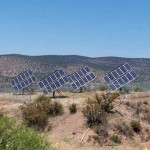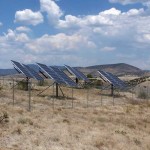
One of the solar arrays used for pumping water to remote pastures.
The Double Circle Ranch is completely off-grid and relies primarily on solar panels, both at our residences and in our pastures. The nearest electric pole is 30 miles away, so if we want electricity, we have to find a way to make and store it ourselves.
For a good introductory explanation of how solar arrays and photovoltaic systems work, check out this page from the Department of Energy.
Solar at home
We have several homesteads at the Double Circle Ranch, each powered by photovoltaic solar panel arrays and battery storage systems. Each home has a dozen L-16 Trojan batteries and a dozen 110-watt Evergreen solar panels. The panels all have Zomeworks trackers on them, which uses Freon gas to allow them to track the sun all day long. This adds some expense to the initial set up of the system, but the addition of the trackers boosts our daily solar output by 20-25%, making them well worth it.
The solar panels absorb the sunlight and charge the batteries during the day; the batteries are fed through an Outback or Xantrex inverter that converts 24V DC to 110V AC, so it’s usable power for the house. At night and on cloudy days we run off the batteries, and if we have several inclement days in a row (monsoon season comes to mind…), we all rely on backup generators to keep the fridge running.
We did all our own research and installation, and our systems work wonderfully. It’s a lot of work up front, but to anyone considering going this route: it’s well worth it!
Living with finite power at home
For someone who has never had the experience of living with finite power, there is a learning curve. Anything with a heating element will draw down a huge amount of power, whether that is a toaster, a clothes dryer, a microwave, a hair dryer or a heating pad. We basically try to avoid these things unless absolutely necessary even during the day, and absolutely after dark.
You learn quickly to shut off your unused power strips, turn off the lights when you leave a room, and not try to do laundry except early on a sunny morning, when the batteries will be able to recharge the rest of the day. For most of us, it only takes a few times of over-using our available power and spending an evening sitting around in the dark before we master the concept of finite power and conservation!
Solar Power in the pasture
We’ve built solar arrays in several of our remote pastures with no natural water source. Solar works great for this, because water can be pumped into a storage tank during daylight hours and then distributed to livestock by gravity whenever and wherever it is needed. Solar pumping allows us to do rotational grazing year-round, meeting the water needs of our cattle herd as well as those of the local wildlife.
Details on array #1

Another of our solar arrays tracks the bright Arizona sun.
Our first solar array pumps two gravity-fed and two pressure-fed systems from a single location. This array covers approximately 20 square miles, 22 miles of pipeline and 20 troughs with wildlife ramps.
- 7.5 gallons per minute pumped to tanks totaling 96,000 gallons of storage
- Covers an 800 foot rise and 3.5 miles
- Uses three submersible pumps at 450 feet in the well beside the pump house
- Uses a piston pump to fill an adjacent 10,000 gallon storage tank
- 50,000 gallon storage tank 3.5 miles away gravity feeds to troughs after being pumped from this system
Details on array #2
Our second solar array is still under construction, and will ultimately cover approximately ten square miles, 12 miles of pipeline, twelve storage tanks and 15 troughs with wildlife ramps.
- Pumps up the hill to two separate systems
- 15-20 gallons per minute currently pumped to two 10,000 gallon storage tanks (ultimately 12 tanks)
- Uses two piston pumps
- Covers a 700 foot rise


